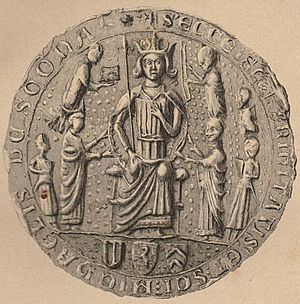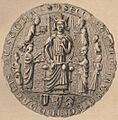Scone Abbey facts for kids
Scone Abbey was a very important religious building in Scone, Scotland. It started as a priory, which is a type of monastery, around 1114 to 1122 AD. It was home to a group of priests called Augustinian canons.
Before the priory, Scone was a special place for a Christian group called the Culdees. They might have worshipped there as early as 700 AD. In 841 AD, Kenneth MacAlpin brought the famous Stone of Scone, also known as the Stone of Destiny, to Scone. This stone was very important for crowning Scottish kings.
Contents
How Scone Priory Began
The priory was started by six canons from Nostell Priory in England. Their leader was Robert of Scone, who became the first prior of Scone. The official document that set up the priory is from 1120.
Historians once thought this document was a fake. But now they believe it's a copy made later, perhaps after a fire around 1163 AD. Many records were also lost during the Wars of Scottish Independence. Scone was a powerful place even before the priory was built.
Becoming an Abbey
In December 1164, during the time of King Malcolm IV of Scotland, Scone Priory became an abbey. This meant it was even more important. Scone Abbey had a special role because it was right next to where Scottish kings were crowned. It also kept the Stone of Scone until King Edward I of England took it.
King Malcolm IV called Scone Abbey "the principal seat of our kingdom." This shows how central it was to Scotland. Kings often stayed at the abbey, hosted by the abbot. The abbey buildings likely stood where Scone Palace is today.
The abbey also held relics of a saint named Saint Fergus. This made it a popular place for people to visit on pilgrimages. Scone Abbey was also known for its music. A composer named Robert Carver created amazing choral music there.
The Scottish Reformation
In 1559, during the Scottish Reformation, Scone Abbey was attacked. A Protestant crowd from Dundee, led by John Knox, burned the abbey down. After this, in 1581, the abbey's lands became a private estate.
The lands were given to William Ruthven, 1st Earl of Gowrie. He owned many castles, including Huntingtower Castle. The Ruthvens rebuilt the old Abbot's Palace into a grand home in 1580.
However, in 1600, King James VI accused the Ruthven family of treason. He took away their lands and banned their name. The Scone lands, including the palace, were then given to Sir David Murray. He became the first Lord Scone.
Even though the abbey was destroyed, some repairs were still made to its church spire in 1620. Scone Abbey stopped being a religious place around 1640. The property has been owned by the Murray family ever since. They later became the Earls of Mansfield. Scone Abbey was a thriving place for over 400 years.
Finding the Abbey Again
For a long time, no one knew exactly where Scone Abbey was located. But in 2007, a team of archaeologists led by Dr. Oliver O'Grady found its exact spot. They used special technology like magnetic resonance imaging.
The discovery showed that the abbey was bigger than people thought. They also found that the Moot hill, a special mound where kings made their vows, was once surrounded by a ditch. This showed it was a very sacred place, not just a defensive one. A picture on an old abbey seal suggests it was a grand Romanesque building with a tall spire. In 2008, archaeologists found three complete human skeletons buried at the abbey site.
Images for kids
See also
 In Spanish: Abadía de Scone para niños
In Spanish: Abadía de Scone para niños







